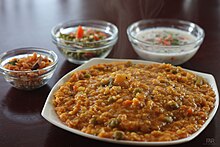Bisi Bele Bath
 Fresh bisi bele bhath | |
| Part of a series on the |
| Culture of Karnataka |
|---|
 |
Bisi bele bhath (bisi bēle bhāt) (Kannada: ಬಿಸಿ ಬೇಳೆ ಭಾತ್) or Bisi Bele Huliyanna(ಬಿಸಿಬೇಳೆಹುಳಿಯನ್ನ) is a spicy, rice-based dish with origins in the state of Karnataka, India.[1] Bisi bele bhath, which translates to 'hot lentil rice dish' in Kannada language, is a wholesome meal. It is said to have originated in the Mysore Palace [citation needed] and Vellore fort [citation needed] and from there spread across the entire states [citation needed] .
Preparation

The traditional preparation of this dish is quite elaborate and involves the use of spicy masala, toor dal (a type of lentil), rice, ghee and vegetables.[2] Spices like nutmeg, asafoetida, curry leaves and tamarind pulp contribute to its unique flavour and taste. Some versions of the dish are prepared with up to thirty ingredients.[3]
It is served hot and sometimes eaten with chutney, boondi, salad, papad, or potato chips. This dish is commonly found in restaurants that serve the Udupi cuisine. The masala used is available off the shelf.
Etymology
The name bisi bēle bhāt is a Kannada phrase, which literally means "hot lentil rice". In Kannada, bisi means hot, bēle means lentil, and bhāt means a dish made of rice.
See also
References
- ^ Philpott, D. (2016). The World of Wine and Food: A Guide to Varieties, Tastes, History, and Pairings. Rowman & Littlefield Publishers. p. 362. ISBN 978-1-4422-6804-3. Retrieved 19 January 2017.
- ^ "Rice Bowl: Vegetarian Rice Recipes from India and the World".
- ^ Cohen, Margot (26 October 2007). "The Dish: Bisi Bele Bath". The Wall Street Journal. Retrieved 19 January 2017. (subscription required)



